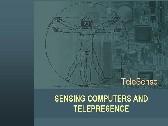

TeleSense: Sensing Computers and Telepresence
The invention of the transistor and the appearance of the first microchips was followed by the PC boom in the eighties. After cheap lasers became available, the unexpected evolution of the Internet amazed the whole world. Since a while, numerous technology analysts suggest that the new millennium will start with the sensor revolution. Indeed, nowadays it is possible to measure several physical characteristics of our environment like color, motion, temperature, humidity, odors and sounds. All these features can be measured quickly and in a parallel manner, and can be stored on any kind of media. However the central issue remains unsolved, i.e. how to design computing devices that can handle the huge quantity of data fed by these parallel sensing networks? The discussion of this problem surfaced a dilemma thought to be resolved: is digital technology the most appropriate way to solve engineering tasks or the sensor revolution will also lead to the renaissance of analog devices? In our opinion, in the near future, most solutions of sensor data processing will be done by combined, analogical systems where analog circuits will take over the sensor-level processing tasks from digital solutions. Furthermore, it is hard to decide the border where it is more efficient to switch from sensor-arranged (topographic) processing methods to other data representations. The solution of this problem becomes truly hard when several sensing modalities have to be processed. In such a case, it is not even clear that during the sensing-processing pathway where we have to start a fusion type signal processing.
The purpose is to investigate efficient computing solutions in processing data flows coming from sensors with various topologies and also to process and analyze events detected by distributed sensor networks. Two important application areas were aimed to explore that can be further developed to create new products and services. The first is a cardiac diagnosis system (Echo) with built-in telepresence feature, while the second is a surveillance system fusing several sensors (spatially integrated [Bi-i] and spatially distributed [MDICam]).